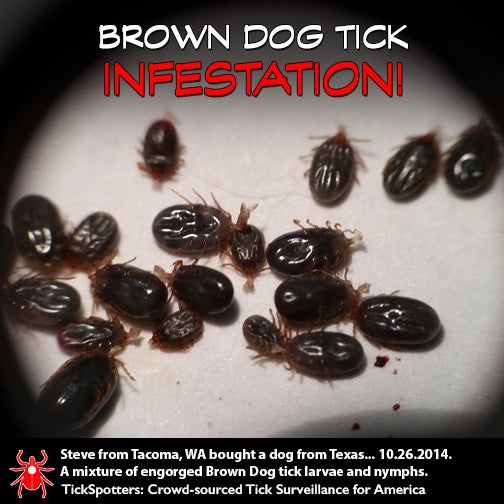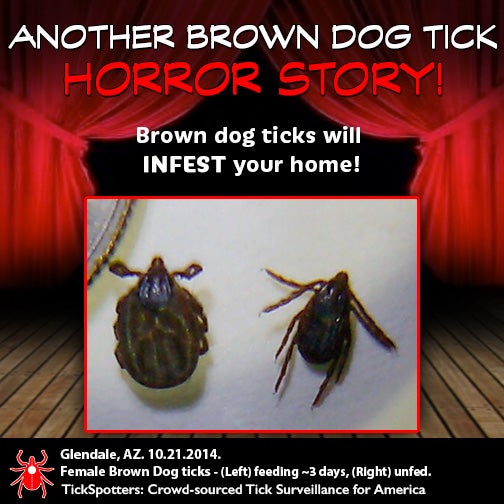October 29, 2014
 Blacklegged (deer) ticks usually take center stage in most people’s tick talk. They ARE a major disease catalyst, capable of transmitting Lyme disease bacteria and at least 4 or 5 additional pathogens to people and pets. But it’s good not to forget the “plain Jane” of ticks — Brown Dog ticks – because they are truly a different kind of horror story. Brown dog ticks don’t transmit Lyme disease but in some regions can transmit Rocky Mountain Spotted fever to people and pets as well as other nasty pet pathogens, including canine babesia, ehrlichia, and anaplasma, and they are the only tick that INFESTS homes.
Blacklegged (deer) ticks usually take center stage in most people’s tick talk. They ARE a major disease catalyst, capable of transmitting Lyme disease bacteria and at least 4 or 5 additional pathogens to people and pets. But it’s good not to forget the “plain Jane” of ticks — Brown Dog ticks – because they are truly a different kind of horror story. Brown dog ticks don’t transmit Lyme disease but in some regions can transmit Rocky Mountain Spotted fever to people and pets as well as other nasty pet pathogens, including canine babesia, ehrlichia, and anaplasma, and they are the only tick that INFESTS homes.
At TickSpotters, TickEncounter’s crowd-sourced tick survey for America, it always feels harsh when we break the news to an uninformed submitter that they have brown dog ticks. It’s not like they’re deer ticks, right? What could be so bad about brown dog ticks? Well, think of brown dog ticks as the cockroach of the tick world. Living in your home, scurrying across the floor or up the walls, dining on your pet…or even you! Once even just one engorged female brown dog tick finds its way into a home or live-on boat, you’ll likely be facing the prospect that they’ll be infesting floor boards, furniture, dropped ceilings and more, in no time. Scary stuff!!
“How did this happen”?
Have you recently had your pets in a kennel or perhaps you recently brought a new dog home from a breeder or the pound? Those are very common ways for these ticks to make it into the home. Once in your home, their numbers can increase relatively quickly; brown dog ticks can complete an entire life cycle–from one engorged female to hundreds of un-engorged adult ticks in a little over 2 months.

“Is there any hope”?
You CAN rid your home of brown dog ticks, but once the pest is identified correctly you need to move quickly and take the most effective actions! Getting rid of brown dog ticks can be a full time job costing hundreds of $$$ or more.
You’ll need to coordinate treatments on your pet with treatments in your home (and possibly in the environment around your home). We recommend that you consider using Bayer’s 8-month Seresto collar for all pets in the household, and start this immediately; because of Seresto’s long-lived tick killing action, it helps avoid gaps in treatment while you’re trying to break the tick cycle in the home. Just one adult female tick that feeds successfully on your pet due to a missed treatment can lay 3,000 eggs or more and just perpetuate the problem. This means that you need to be extremely consistent with your efforts and use the best products available.
We also recommend finding an exterminator having successful experiences with brown dog tick control in the home and around the yard (you might even ask for references). You’ll likely need one or two in-home and possibly around the yard treatments, in conjunction with the on-pet protection. Other popularly reported strategies like dips, shampoos or diatomaceous earth may kill a few ticks but you’ve got to be very effective to break this tick’s life cycle if you hope to eliminate it from your house.
A recent TickSpotter story from Kevin in Glendale, AZ.
 “Thanks so much for the information.
“Thanks so much for the information.
It is indeed an infestation. I have been working diligently to remove from the dog, the cat, and the walls and rest of the house and this information will be helpful moving forward. Two-three weeks ago I was removing “seedlike” ticks from the dog. Now they appear more like little spiders.
The dog has been treated with [tick control]. It does not seem to be working.
The dog has been bathed with flea and tick shampoo, which seems to send the ticks running initially, but a few days later they can be found on the dog.
The cat has also been bathed with flea and tick shampoo, which seems to help—though it is difficult to tell because the cat is not cooperative when it comes to checking for ticks!
The local natural pet food store sent me home with a 50 lb bag of diatomaceous earth and suggested it was a natural way to control ticks on the dog, in the home, and in the yard. That was going to be my next plan of attack.
The dog has not been to any kennels or anywhere else exotic. We have a band of raccoons** that roam the neighborhood and I wonder if they could be responsible, with ticks moving from them to bushes and then to my dog (who loves getting into bushes).
I grew up in western NY, we were always cognizant of ticks. Who knew they’d be in the desert!
I appreciate you taking the time to contact me. And I surely would welcome any additional advice or information.”
**One note from Kevin’s story: Brown Dog ticks are a fairly commonly tick encounter in the Phoenix area. Perhaps a neighbor also has an infestation. We don’t think Kevin’s “plague” came from the local raccoons. We hope Kevin checks back in, and we’ll post any updates on this page.
Yet another horror story! Steve from Tacoma, WA bought a dog from Texas…
 Steve from Tacoma, WA,
Steve from Tacoma, WA,
“We live in Tacoma, WA and bought a dog from Texas. It arrived with about 100 engorged ticks on it. We have been plucking, washing and medicating the last 2 days.”
Yikes! That’s definitely NOT one of the first experiences you’d like to have with a new pup.
We’re getting an awful lot of Brown Dog tick stories these days. Everyone might want to also take a look at a couple of other Tick Notes that relate to this same problem — “Ticks crawling up my walls. Help!! ” and “The difference between inside ticks and ticks inside”.
